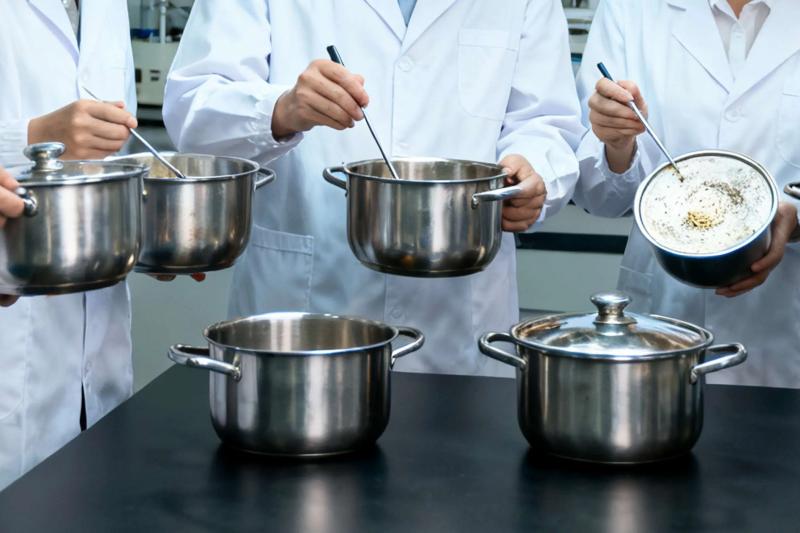
Among the various utensils in the kitchen, the stainless steel pot might be the most common one. It sits quietly on the stovetop, witnessing the creation of every delicious meal. However, you might not know that this seemingly ordinary kitchen companion was once a "star material" in the field of aerospace. Today, let’s uncover the mysterious "resume" of the stainless steel pot and explore its legendary journey from aerospace to the kitchen.

The Birth of Stainless Steel: A Crystallization of Technology and Serendipity
(I) An Accidental Discovery
The story dates back to the early 20th century. British scientist Harry Brearley was commissioned by a British government arsenal to research improvements for firearms. He sought to develop a wear-resistant and rust-resistant alloy steel for manufacturing gun barrels. During numerous experiments, he added chromium to steel and obtained an alloy with good corrosion resistance. However, this alloy lacked sufficient hardness for gun barrel production, so he discarded these rejected alloys into the scrap heap.
Months later, while cleaning the scrap pile, Brearley made a surprising discovery: while other steels had rusted extensively, these chromium-containing alloys remained as bright as new. This accidental finding made him realize the unique anti-corrosion properties of this alloy. Through further research, he determined its composition and characteristics, marking the birth of stainless steel.
(II) Emerging Properties
Stainless steel is primarily composed of iron, chromium, nickel, and other elements. Chromium serves as the key element imparting corrosion resistance. When the chromium content reaches 10.5% or higher, a dense chromium oxide film forms on the steel's surface. This film prevents oxygen and moisture from penetrating further into the steel, thus inhibiting rust formation. Additionally, stainless steel possesses high strength, heat resistance, ease of processing, and other characteristics that demonstrated immense application potential from its very inception.
Entering Aerospace: Shining in the Cosmos
(I) The Choice for Extreme Environments
As humanity's desire to explore the cosmos grew increasingly stronger, aerospace technology advanced rapidly. The manufacturing of spacecraft demands exceptionally stringent requirements for materials. In space, spacecraft must endure extreme temperature fluctuations, intense radiation, and micro-meteoroid impacts—harsh conditions under which ordinary materials struggle to maintain stable performance. It was stainless steel's exceptional corrosion resistance, high strength, and excellent heat resistance that made it an ideal choice for the aerospace field.
(II) Widespread Applications in Aerospace

In spacecraft manufacturing, stainless steel found extensive use in multiple critical components. For instance, the spacecraft's outer shell must withstand tremendous pressure and temperature variations. Stainless steel's high strength and heat resistance ensure the structural integrity of the hull, protecting both internal equipment and astronaut safety. Simultaneously, spacecraft piping systems also heavily utilize stainless steel. These pipelines transport fuel, coolant, and other substances, where stainless steel's anti-corrosion properties prevent rust and leakage, ensuring normal spacecraft operation.
Furthermore, stainless steel plays a significant role in spacesuit manufacturing. Spacesuits require optimal protective capabilities and comfort. The high strength and workability of stainless steel allow it to be fashioned into various shaped components, providing reliable protection for astronauts.
Entering the Kitchen: From High-End to Down-to-Earth

(I) Performance Tailored for Kitchen Needs
With continuous technological advancements, the production cost of stainless steel gradually decreased, and its application scope expanded. People began exploring ways to apply this excellent material to daily life. The kitchen, as a central hub of household activity, demands high performance from cookware. Stainless steel’s corrosion resistance allows it to resist rust in humid kitchen environments, maintaining long-term aesthetics and hygiene. Its excellent thermal conductivity ensures even heat distribution, preventing localized overheating or undercooking, thereby enhancing cooking quality. Moreover, stainless steel’s high strength makes pots and pans more durable and less prone to deformation, meeting the demands of everyday home cooking.
(II) Process Improvements and Popularization
To better adapt stainless steel for kitchen use, scientists and engineers continuously refined its processing techniques. Special surface treatments made stainless steel cookware smoother, reducing food sticking and simplifying cleaning. Simultaneously, designs became more user-centric, incorporating ergonomic handles for a more comfortable grip.
As production technology matured and mass production became feasible, the price of stainless steel cookware gradually decreased, making it more affordable. An increasing number of households began choosing stainless steel cookware as their go-to kitchen tools, and it soon became a standard fixture in kitchens.
Future Prospects: The Infinite Possibilities of Stainless Steel Cookware
With the ongoing development of technology, the future of stainless steel cookware is filled with limitless possibilities. Scientists may develop even more advanced stainless steel materials to further enhance performance. For instance, self-cleaning stainless steel cookware could use special surface coating technology to automate cleaning after use, reducing the burden on users. Additionally, smart stainless steel cookware could become a future trend, featuring built-in sensors and intelligent control systems to enable automatic cooking and temperature adjustment, making cooking easier and more convenient.
Hongwang Holding Group ranks 451st in the 2021 Top 500 Chinese Enterprises
2021-09-26Get In Hongwang's Dream Car Together
2022-03-28Hongwang's intelligent made,A stunning appearance at the 133rd Canton Fair
2023-04-23Hunan Hongwang silicon steel project officially starts production
2023-03-28HONGWANG STAINLESS STEEL X HONGSCO YOUTH SERIES
2022-11-11The Center Of Attention--Hongwang Black Ti Series
2023-07-10






